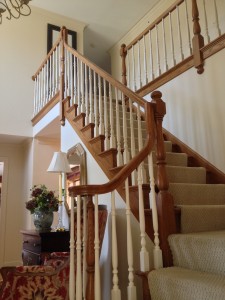As Painting and decorating contractors, we do the maintenance painting and restoration work on many historical and “period” houses in the Chicago area. One of those properties is in Oak Park and is an 1870’s Victorian house. The front porch faces North and is in the shade all day long. Consequently, it is quite vulnerable to the ravages of moisture and weather.
The banisters were made of 10”x2” pieces of lumber held together side by side, tooled and beveled to create a beautiful pattern. Unfortunately, that design created scores of possible access points to moisture due to movement between the boards or the boards and the bottom rail. The bottom posts were equally vulnerable because the moisture would gather at the bottom of the lower rail, next to the posts. Needless to say, the banisters had to be rebuilt on multiple occasions over the years.
The owner of Donatelli Builders , whom we use in all our historical wood repairs, believes in using materials that offer the maximum longevity possible. So he told me about the possibility of using PVC to recreate the banister and posts designs. I talked to the owner about the idea and he all for it since the original design could be faithfully replicated, while achieving greater longevity at the same time.
One word of caution is in order about using PVC and dark paint colors. On the North side of a house, color choices do not affect PVC. However, before using PVC on the other sides of a house, the LRV (Light Reflectance Value) of the colors to be used must be considered. The lower the LRV (darker colors), the light/heat will be absorbed by the color and the higher the risk that the heat will distort the PVC, causing it to loose its shape.
Using modern materials can help prolong the life and beauty of vintage designs, as well as help reduce the maintenance costs to the owners. However, they must be used judiciously.











 Follow
Follow











